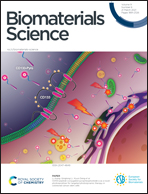In vitro vascularization of tissue engineered constructs by non-viral delivery of pro-angiogenic genes†
Abstract
Vascularization is still one of the major challenges in tissue engineering. In the context of tissue regeneration, the formation of capillary-like structures is often triggered by the addition of growth factors which are associated with high cost, bolus release and short half-life. As an alternative to growth factors, we hypothesized that delivering genes-encoding angiogenic growth factors to cells in a scaffold microenvironment would lead to a controlled release of angiogenic proteins promoting vascularization, simultaneously offering structural support for new matrix deposition. Two non-viral vectors, chitosan (Ch) and polyethyleneimine (PEI), were tested to deliver plasmids encoding for vascular endothelial growth factor (pVEGF) and fibroblast growth factor-2 (pFGF2) to human dermal fibroblasts (hDFbs). hDFbs were successfully transfected with both Ch and PEI, without compromising the metabolic activity. Despite low transfection efficiency, superior VEGF and FGF-2 transgene expression was attained when pVEGF was delivered with PEI and when pFGF2 was delivered with Ch, impacting the formation of capillary-like structures by primary human dermal microvascular endothelial cells (hDMECs). Moreover, in a 3D microenvironment, when PEI-pVEGF and Ch-FGF2 were delivered to hDFbs, cells produced functional pro-angiogenic proteins which induced faster formation of capillary-like structures that were retained in vitro for longer time in a Matrigel assay. The dual combination of the plasmids resulted in a downregulation of the production of VEGF and an upregulation of FGF-2. The number of capillary-like segments obtained with this system was inferior to the delivery of plasmids individually but superior to what was observed with the non-transfected cells. This work confirmed that cell-laden scaffolds containing transfected cells offer a novel, selective and alternative approach to impact the vascularization during tissue regeneration. Moreover, this work provides a new platform for pathophysiology studies, models of disease, culture systems and drug screening.



 Please wait while we load your content...
Please wait while we load your content...